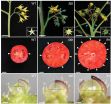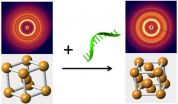(Press-News.org) Ovarian cancer is notoriously difficult to diagnose and treat, making it an especially fatal disease. Researchers at University of California, San Diego School of Medicine and Moores Cancer Center have now identified six mRNA isoforms (bits of genetic material) produced by ovarian cancer cells but not normal cells, opening up the possibility that they could be used to diagnose early-stage ovarian cancer. What's more, several of the mRNA isoforms code for unique proteins that could be targeted with new therapeutics. The study is published the week of May 25 by the Proceedings of the National Academy of Sciences.
"We were inspired by many studies aimed at using DNA to detect cancer," said first author Christian Barrett, PhD, bioinformatics expert and project scientist in the UC San Diego School of Medicine Institute for Genomic Medicine. "But we wondered if we could instead develop an ovarian cancer detection test based on tumor-specific mRNA that has disseminated from cancer cells to the cervix and can be collected during a routine Pap test."
While DNA carries all the instructions necessary for life, its actual sequence contains much more than just the genes that code for proteins. In contrast, mRNAs are complementary copies of just the genes. They carry the recipe for every protein that the cell will produce from the nucleus to the cytoplasm, where cellular machinery can read the recipe and build the corresponding proteins. According to the authors of this study, the advantage of using cancer mRNA for diagnosis rather than DNA is sheer number -- a cancer cell might harbor just one or a few copies of a DNA mutation, but mRNA variants can occur in hundreds to thousands of copies per cell.
To determine if mRNAs can be used to distinguish ovarian cancer cells from normal cells, the team developed a custom bioinformatics algorithm and used it to mine two large public databases of genetic information -- The Cancer Genome Atlas (TCGA) and the Genotype-Tissue Expression (GTEx) program, both sponsored by the National Institutes of Health. TCGA is a catalog of RNA and DNA from 500 tumors covering many cancer types, while GTEx is a database of RNA and DNA from normal tissue samples. From these, the researchers were able to analyze mRNA sequence data from 296 ovarian cancers and 1,839 normal tissue samples.
Using this bioinformatics approach, the researchers identified six mRNA isoform molecules that have the tumor specificity required for an early detection diagnostic of ovarian cancer. They also validated their digital results in the real world using RT-quantitative PCR, a gene amplifying technique, to detect the same ovarian cancer-specific mRNA molecules in lab-grown cells.
Beyond their diagnostic potential, some of the mRNA isoforms identified in this study could also act as new therapeutic targets. These mRNA isoforms are predicted to encode proteins with unique amino acid sequences, which might allow them to be specifically targeted with certain therapeutics, such as monoclonal antibodies or T-cell-based vaccines. What's more, the ovarian cancer-specific mRNA isoforms themselves could also be targeted with new therapeutic drugs.
"Our experimental findings were made in a laboratory and were performed on ovarian cancer cells from cell lines," said study co-author Cheryl Saenz, MD, a clinical professor of reproductive medicine who specializes in treating gynecologic cancers. "Clinical trials will need to be conducted on women to confirm the presence of these markers in women that we know have cancer, as well as to document the absence of the markers in women that do not have ovarian cancer."
The authors acknowledge a few limitations to their approach, including technical limitations in detecting mRNA isoforms, a shortage of normal ovarian and fallopian tube control samples and the possibility that tumor cells that disseminate to the cervix may not genetically act the same as the primary tumor.
Still, based on these promising initial results, the authors recommend expanding their process for identifying tumor-specific mRNA isoforms to the 30 additional tumor types for which sufficient amounts of RNA sequence already exist.
Iris and Matthew Strauss, San Diego-based philanthropists who helped fund the study, are also excited by the promise this finding holds. "We created the Iris and Matthew Strauss Center for Early Detection of Ovarian Cancer in memory of our daughter, Stefanie Dawn Strauss," said Iris Lynn Strauss. "To further honor our daughter, we provided support for this study in an effort to help other women obtain early detection from this dreadful and deadly disease."
INFORMATION:
Additional co-authors of this study include Christopher DeBoever, Kristen Jepsen, Dennis A. Carson, and Kelly A. Frazer, all of UC San Diego.
This research was also funded, in part, by the National Cancer Institute (grant P30CA023100) and Colleen's Dream Foundation.
Frailer older patients are at higher risk of readmission to hospital or death within 30 days after discharge from a general internal medicine ward, but health care professionals can assess who is at risk using the Clinical Frailty Scale, according to a study in CMAJ (Canadian Medical Association Journal)
Readmission within 30 days after hospital discharge is common and also costly for the health care system. Identifying at-risk patients and addressing the factors contributing to readmission can help reduce recurrences. However, current tools are not able to predict accurately ...
This news release is available in French. Scientists measuring brain activity have found that in many regions, such as the sensory or motor cortex, activity sometimes oscillates at different frequencies, forming wave-like patterns. Despite the fact that such oscillations are frequently observed, and present in many brain regions, their functional role remains unclear. Research done by Dr. Christopher Pack, from McGill University, who looked at such waves occurring in a region of the visual cortex of the brain, suggests these oscillations could have a role in resetting ...
Cold Spring Harbor, NY -- A team of scientists at Cold Spring Harbor Laboratory (CSHL) has identified a set of genes that control stem cell production in tomato. Mutations in these genes explain the origin of mammoth beefsteak tomatoes. More important, the research suggests how breeders can fine-tune fruit size in potentially any fruit-bearing crop. The research appears online today in Nature Genetics.
In its original, wild form the tomato plant produces tiny, berry-sized fruits. Yet among the first tomatoes brought to Europe from Mexico by conquistador Hernan Cortez in ...
UPTON, NY -- Scientists at the U.S. Department of Energy's Brookhaven National Laboratory have just taken a big step toward the goal of engineering dynamic nanomaterials whose structure and associated properties can be switched on demand. In a paper appearing in Nature Materials, they describe a way to selectively rearrange the nanoparticles in three-dimensional arrays to produce different configurations, or phases, from the same nano-components.
"One of the goals in nanoparticle self-assembly has been to create structures by design," said Oleg Gang, who led the work ...
New research conducted in a rural community in Pakistan highlights the crucial role that essential fatty acids play in human brain growth and function.
A team co-led by the University of Exeter, working with experts in Singapore, has published findings in Nature Genetics which show that mutations in the protein Mfsd2a cause impaired brain development in humans. Mfsd2a is the transporter in the brain for a special type of fat called lysophosphatidylcholines (LPCs) -- which are composed of essential fatty acids like omega-3. This shows the crucial role of these fats in ...
Having a healthy gut may well depend on maintaining a complex signaling dance between immune cells and the stem cells that line the intestine. Scientists at the Buck Institute are now reporting significant new insight into how these complex interactions control intestinal regeneration after a bacterial infection. It's a dance that ensures repair after a challenge, but that also goes awry in aging fruit flies -- the work thus offers important new clues into the potential causes of age-related human maladies, such as irritable bowel syndrome, leaky gut and colorectal cancer.
"We've ...
May 26, 2015, Shenzhen, China - Researchers from BGI reported the most complete haploid-resolved diploid genome (HDG) sequence based on de novo assembly with NGS technology and the pipeline developed lays the foundation for de novo assembly of genomes with high levels of heterozygosity. The latest study was published online today in Nature Biotechnology.
The human genome is diploid, and knowledge of the variants on each chromosome is important for the interpretation of genomic information. In this study, researchers presented the assembly of a haplotype-resolved diploid ...
A gene essential to the production of pain-sensing neurons in humans has been identified by an international team of researchers co-led by the University of Cambridge. The discovery, reported today in the journal Nature Genetics, could have implications for the development of new methods of pain relief.
Pain perception is an evolutionarily-conserved warning mechanism that alerts us to dangers in the environment and to potential tissue damage. However, rare individuals - around one in a million people in the UK - are born unable to feel pain. These people accumulate numerous ...
Scientists at the University of York's Centre for Quantum Technology have made an important step in establishing scalable and secure high rate quantum networks.
Working with colleagues at the Technical University of Denmark (DTU), Massachusetts Institute of Technology (MIT), and the University of Toronto, they have developed a protocol to achieve key-rates at metropolitan distances at three orders-of-magnitude higher than previously.
Standard protocols of Quantum Key Distribution (QKD) exploit random sequences of quantum bits (qubits) to distribute secret keys in a completely ...
TORONTO, May 25, 2015 - A new, Ontario-wide study shows that rates of hospital readmission following a traumatic brain injury (TBI) are greater than other chronic diseases and injuries and are higher than previously reported.
The study, led by Dr. Angela Colantonio, senior scientist, Toronto Rehabilitation Institute, UHN, examined nearly 30,000 TBI patients discharged from Ontario hospitals over the span of eight years. Published in the May edition of Archives of Physical Medicine and Rehabilitation, the study found that about 36 per cent of patients with TBI had been ...

